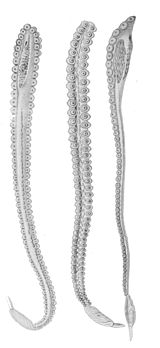
Back Хектокотил Bulgarian Hektokotylus Czech Hectocotylus German Hektokotilo Esperanto Hectocotylus Spanish Ektokotilo Basque Hectocotyle French Hectocótilo Galician 交接腕 Japanese Hectocotylus NDS

A hectocotylus (pl.: hectocotyli) is one of the arms of male cephalopods that is specialized to store and transfer spermatophores to the female.[1] Structurally, hectocotyli are muscular hydrostats. Depending on the species, the male may use it merely as a conduit to the female, analogously to a penis in other animals, or he may wrench it off and present it to the female.
The hectocotyl arm was first described in Aristotle's biological works. Although Aristotle knew of its use in mating, he was doubtful that a tentacle could deliver sperm. The name hectocotylus was devised by Georges Cuvier, who first found one embedded in the mantle of a female argonaut. Supposing it to be a parasitic worm, in 1829 Cuvier gave it a generic name,[2][3][4][5] combining the Greek word for "hundred" and Latin word for "hollow thing, cup".
- ^ Roger T. Hanlon; John B. Messenger (22 March 2018). Cephalopod Behaviour. Cambridge University Press. ISBN 978-1-108-54674-4.
- ^ Leroi, Armand Marie (25 September 2014). The Lagoon: How Aristotle Invented Science. Penguin. ISBN 9780698170391.
- ^ Thompson, D'Arcy Wentworth (1913). On Aristotle as a biologist, with a prooemion on Herbert Spencer. Being the Herbert Spencer Lecture before the University of Oxford, on February 14, 1913. Oxford University Press. p. 19.
- ^ Nixon M.; Young J.Z. (2003). The brains and lives of Cephalopods. Oxford University Press. ISBN 9780198527619.
- ^ "GBIF:Hectocotylus Cuvier, 1829". Retrieved 21 November 2016.
© MMXXIII Rich X Search. We shall prevail. All rights reserved. Rich X Search